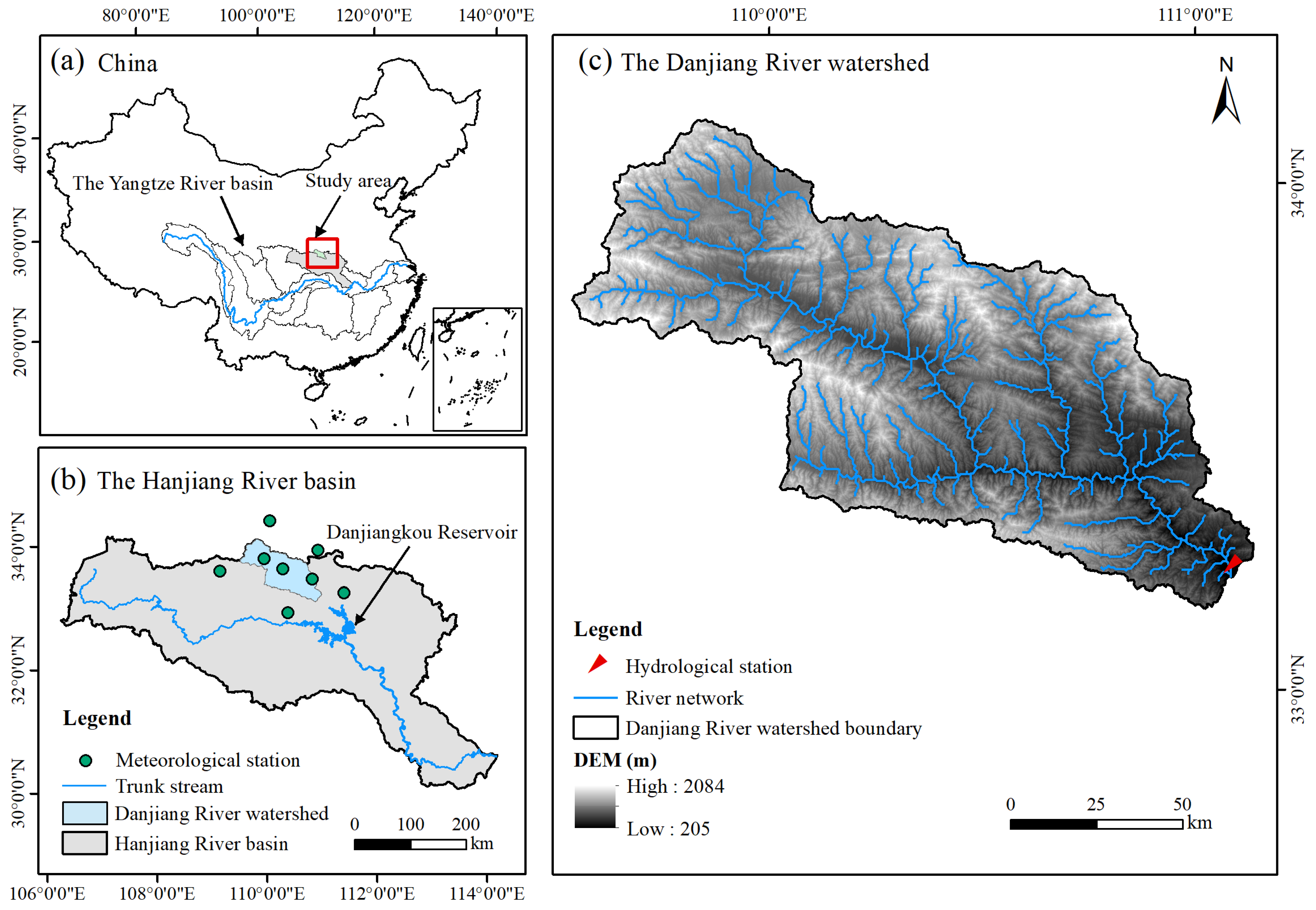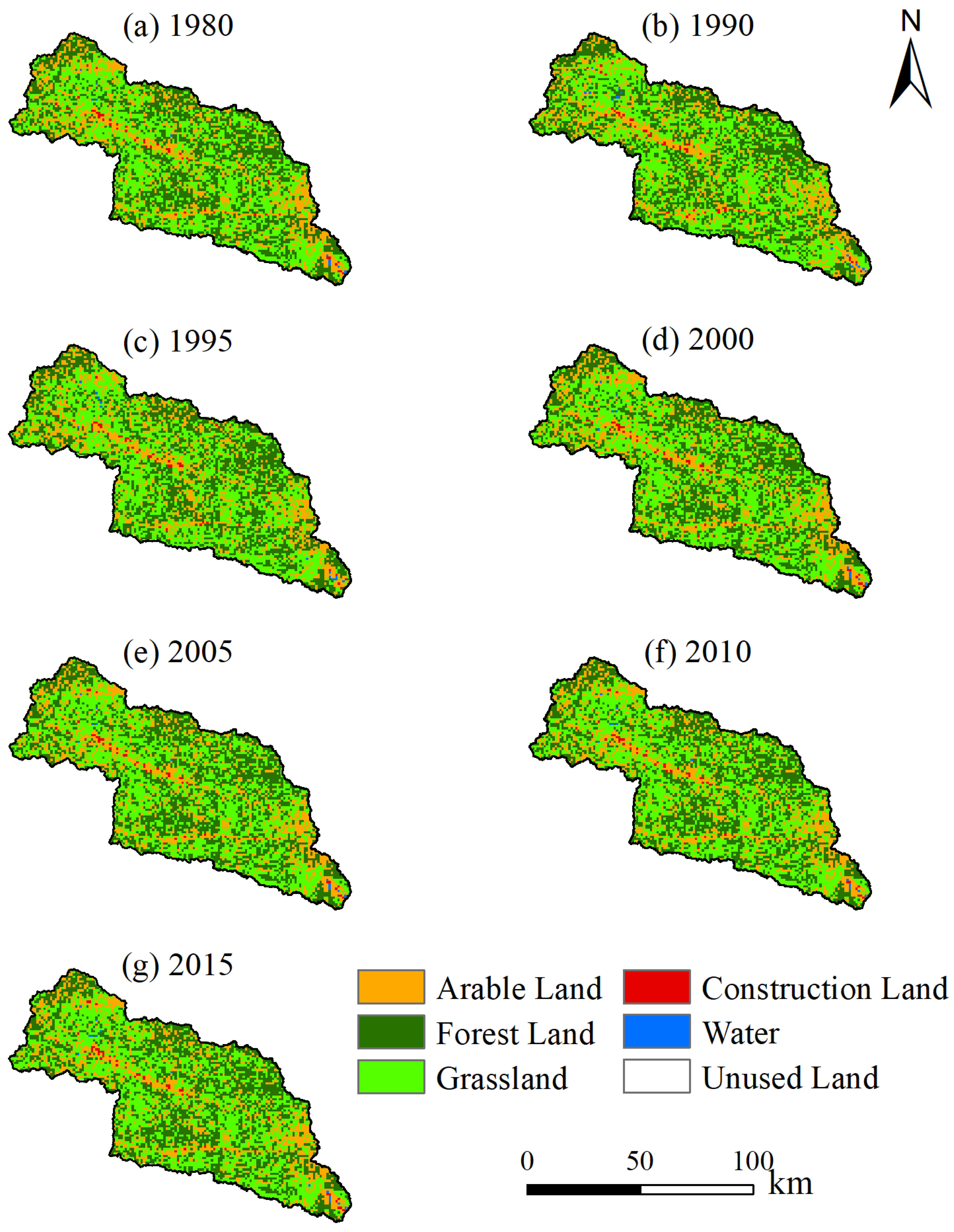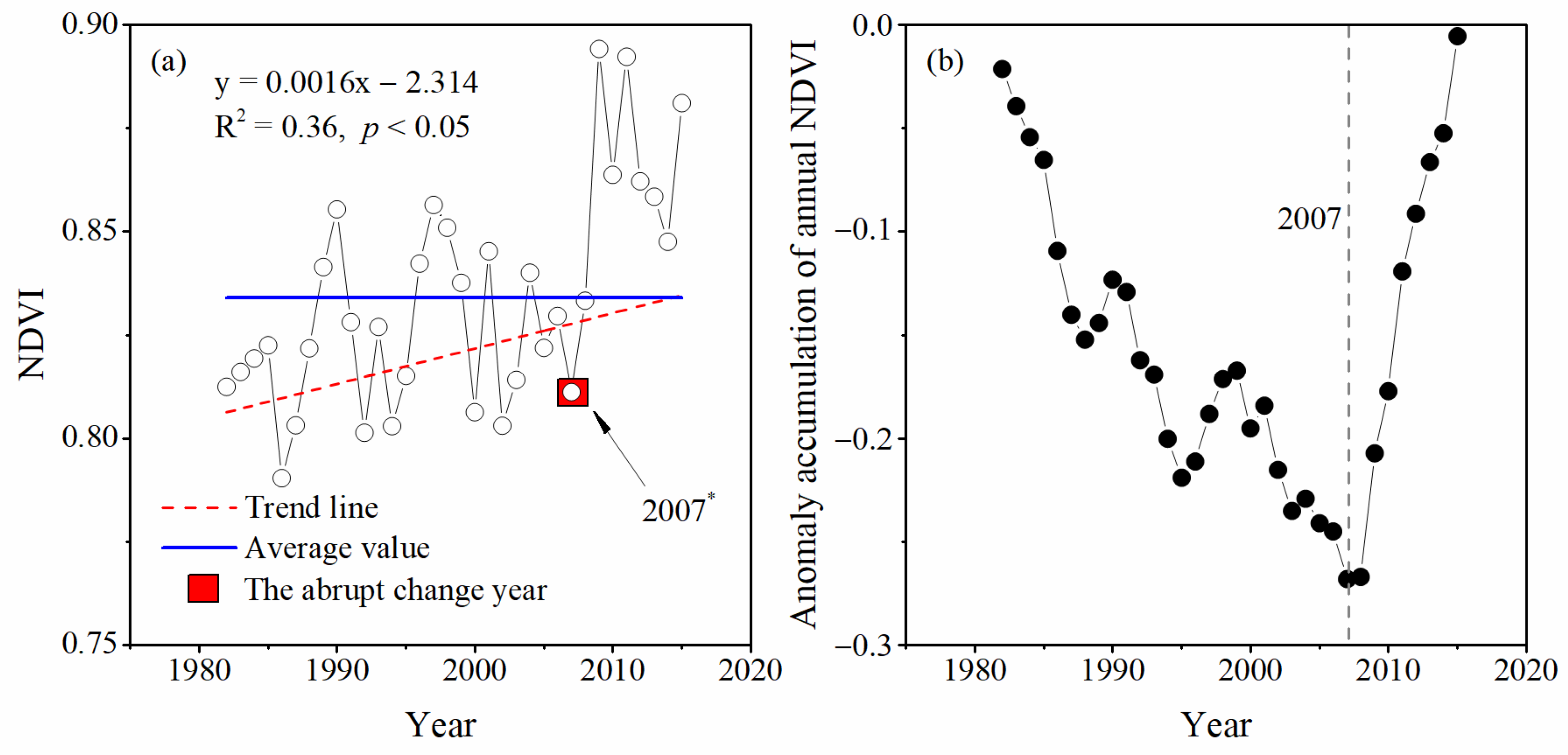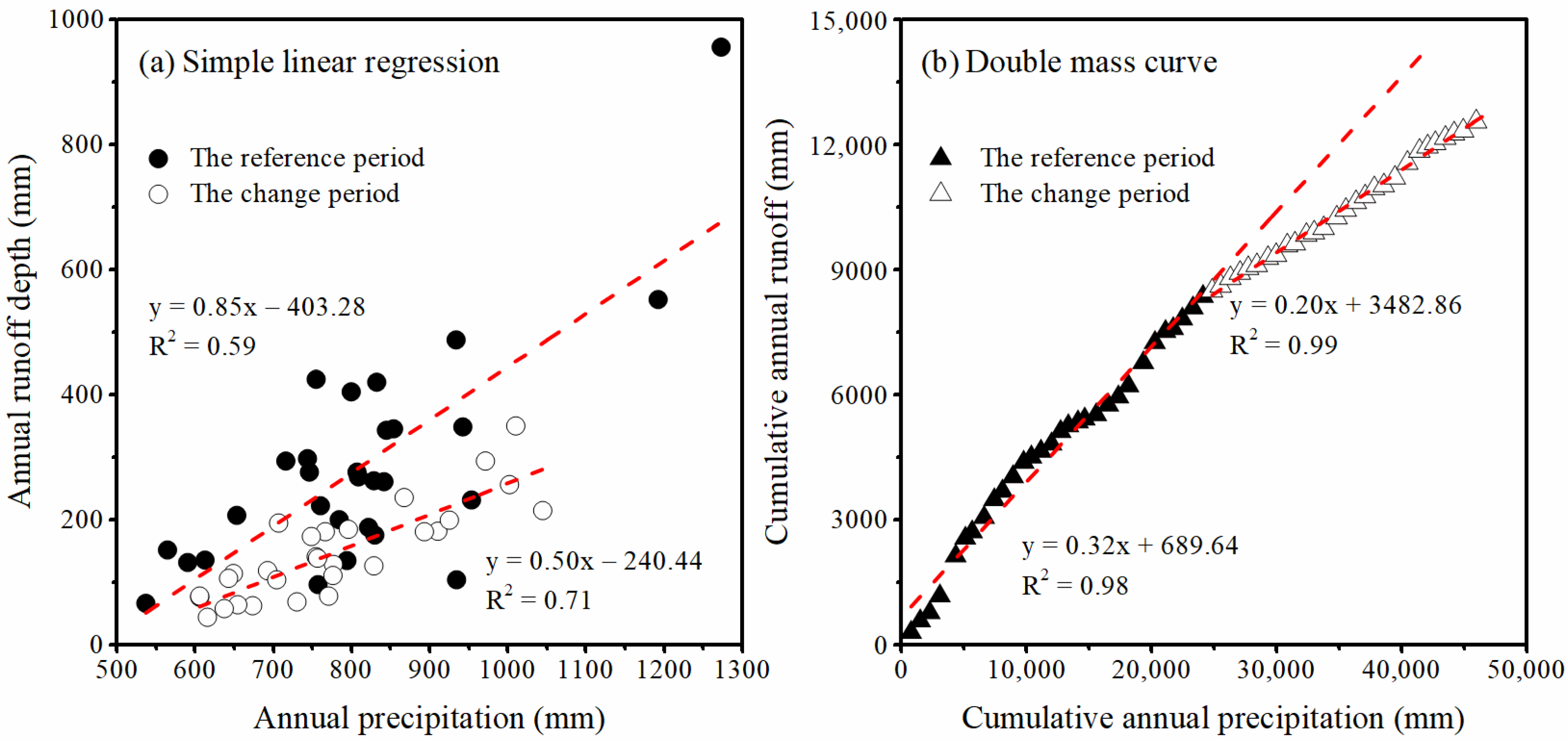An Attribution Analysis of Runoff Alterations in the Danjiang River Watershed for Sustainable Water Resource Management by Different Methods
Abstract
1. Introduction
2. Materials and Methods
2.1. Study Area
2.2. Data Source
2.3. Methodology
2.3.1. The Identification of Change Trend
2.3.2. The Determination of Reference and Change Period
2.3.3. The Quantization of the Effects
Simple Linear Regression
Double Mass Curve
The Elasticity Method Based on the Budyko Framework
Paired Year with Similar Climate Conditions
2.4. The Evaluation of Methods
3. Results
3.1. Hydro-Meteorological Characteristics Variations
3.2. Changes in Land Use and Vegetation Cover
3.2.1. Land Use Changes
3.2.2. Spatiotemporal Variations of NDVI Vegetation Patterns
3.3. Hydrological Simulations
3.4. Quantifications of Effects on Runoff Variation
3.4.1. Simple Linear Regression
3.4.2. Double Mass Curve
3.4.3. The Budyko Framework
3.4.4. Paired Year with Similar Climate Conditions
4. Discussion
4.1. Comparison of the Results
4.2. Applicability and Limitations of the Chosen Methods
4.3. Implications of This Study
5. Conclusions
- (1)
- Annual runoff in the Danjiang River watershed significantly decreased by 3.88 mm every year (p < 0.05) from 1960 to 2017. The significant change point was identified as the year of 1989, dividing the entire period into the reference period (1960–1989) and the change period (1990–2017).
- (2)
- As for the method of paired year with similar climate conditions, the contribution of human activity estimated varied greatly among paired years, whereas the other three approaches produced a similar result that significant runoff reduction was mainly attributed to human activity, with a contribution of 80.22–92.88% (mean 86.33%).
- (3)
- By taking into account principles of isolating the hydrological impacts in each method, four approaches produced consistent estimations. In comparison, empirical statistical methods could be applied to quantify hydrological responses to climate change and human activity in watersheds where runoff is closely related to precipitation. When employing the paired year with the similar climate conditions method, more representative paired years can be selected based on more detailed meteorological data. The elasticity method based on the Budyko framework provides valuable references for evaluating the contribution of land surface alteration to runoff variation. The result is critical for water resource management, and it has implications for maintaining sustainable water resource supplies from similar watersheds.
Author Contributions
Funding
Institutional Review Board Statement
Informed Consent Statement
Data Availability Statement
Conflicts of Interest
References
- Coppola, E.; Verdecchia, M.; Giorgi, F.; Colaiuda, V.; Tomassetti, B.; Lombardi, A. Changing hydrological conditions in the Po basin under global warming. Sci. Total Environ. 2014, 493, 1183–1196. [Google Scholar] [CrossRef]
- Liu, K.; Li, X.; Wang, S. Characterizing the spatiotemporal response of runoff to impervious surface dynamics across three highly urbanized cities in southern China from 2000 to 2017. Int. J. Appl. Earth Obs. Geoinf. 2021, 100, 102331. [Google Scholar] [CrossRef]
- Li, Z.; Huang, S.; Liu, D.; Leng, G.; Zhou, S.; Huang, Q. Assessing the effects of climate change and human activities on runoff variations from a seasonal perspective. Stoch. Environ. Res. Risk Assess. 2020, 34, 575–592. [Google Scholar] [CrossRef]
- Moragoda, N.; Cohen, S. Climate-induced trends in global riverine water discharge and suspended sediment dynamics in the 21st century. Glob. Planet. Chang. 2020, 191, 103199. [Google Scholar] [CrossRef]
- Yin, S.; Gao, G.; Li, Y.; Xu, Y.J.; Turner, R.E.; Ran, L.; Wang, X.; Fu, B. Long-term trends of streamflow, sediment load and nutrient fluxes from the Mississippi River Basin: Impacts of climate change and human activities. J. Hydrol. 2023, 616, 128822. [Google Scholar] [CrossRef]
- Tian, S.; Xu, M.; Jiang, E.; Wang, G.; Hu, H.; Liu, X. Temporal variations of runoff and sediment load in the upper Yellow River, China. J. Hydrol. 2019, 568, 46–56. [Google Scholar] [CrossRef]
- Zhao, Y.; Zou, X.; Gao, J.; Xu, X.; Wang, C.; Tang, D.; Wang, T.; Wu, X. Quantifying the anthropogenic and climatic contributions to changes in water discharge and sediment load into the sea: A case study of the Yangtze River, China. Sci. Total Environ. 2015, 536, 803–812. [Google Scholar] [CrossRef]
- Mahmoodi, N.; Osati, K.; Salajegheh, A.; Saravi, M.M. Assessing the trends of streamflow and its linkages with climate variables in the Dez river basin, Iran. Int. J. Environ. Sci. Technol. 2021, 19, 107–120. [Google Scholar] [CrossRef]
- Quang, N.H.; Viet, T.Q.; Thang, H.N.; Hieu, N.T.D. Long-term water level dynamics in the Red River basin in response to anthropogenic activities and climate change. Sci. Total Environ. 2024, 912, 168985. [Google Scholar] [CrossRef]
- Sun, Y.; Tian, F.; Yang, L.; Hu, H. Exploring the spatial variability of contributions from climate variation and change in catchment properties to streamflow decrease in a mesoscale basin by three different methods. J. Hydrol. 2014, 508, 170–180. [Google Scholar] [CrossRef]
- Bloeschl, G.; Hall, J.; Viglione, A.; Perdigao, R.A.P.; Parajka, J.; Merz, B.; Lun, D.; Arheimer, B.; Aronica, G.T.; Bilibashi, A.; et al. Changing climate both increases and decreases European river floods. Nature 2019, 573, 108–111. [Google Scholar] [CrossRef] [PubMed]
- Berihun, M.L.; Tsunekawa, A.; Haregeweyn, N.; Dile, Y.T.; Tsubo, M.; Fenta, A.A.; Meshesha, D.T.; Ebabu, K.; Sultan, D.; Srinivasan, R. Evaluating runoff and sediment responses to soil and water conservation practices by employing alternative modeling approaches. Sci. Total Environ. 2020, 747, 141118. [Google Scholar] [CrossRef]
- Hu, Y.; Duan, W.; Chen, Y.; Zou, S.; Kayumba, P.M.; Sahu, N. An integrated assessment of runoff dynamics in the Amu Darya River Basin: Confronting climate change and multiple human activities, 1960–2017. J. Hydrol. 2021, 603, 126905. [Google Scholar] [CrossRef]
- Wang, S.; Chen, F.; Hu, M.; Chen, Y.; Cao, H.; Yue, W.; Zhao, X. Past, present and future changes in the annual streamflow of the Lancang-Mekong River and their driving mechanisms. Sci. Total Environ. 2024, 947, 174707. [Google Scholar] [CrossRef] [PubMed]
- Ahn, K.-H.; Merwade, V. Quantifying the relative impact of climate and human activities on streamflow. J. Hydrol. 2014, 515, 257–266. [Google Scholar] [CrossRef]
- Dey, P.; Mishra, A. Separating the impacts of climate change and human activities on streamflow: A review of methodologies and critical assumptions. J. Hydrol. 2017, 548, 278–290. [Google Scholar] [CrossRef]
- Zhang, A.; Zhang, C.; Fu, G.; Wang, B.; Bao, Z.; Zheng, H. Assessments of Impacts of Climate Change and Human Activities on Runoff with SWAT for the Huifa River Basin, Northeast China. Water Resour. Manag. 2012, 26, 2199–2217. [Google Scholar] [CrossRef]
- Brighenti, T.M.; Bonuma, N.B.; Grison, F.; Mota, A.d.A.; Kobiyama, M.; Borges Chaffe, P.L. Two calibration methods for modeling streamflow and suspended sediment with the swat model. Ecol. Eng. 2019, 127, 103–113. [Google Scholar] [CrossRef]
- Ning, T.; Li, Z.; Liu, W. Separating the impacts of climate change and land surface alteration on runoff reduction in the Jing River catchment of China. Catena 2016, 147, 80–86. [Google Scholar] [CrossRef]
- Zheng, J.; He, Y.; Jiang, X.; Nie, T.; Lei, Y. Attribution Analysis of Runoff Variation in Kuye River Basin Based on Three Budyko Methods. Land 2021, 10, 1061. [Google Scholar] [CrossRef]
- Yang, L.; Zhao, G.; Tian, P.; Mu, X.; Tian, X.; Feng, J.; Bai, Y. Runoff changes in the major river basins of China and their responses to potential driving forces. J. Hydrol. 2022, 607, 127536. [Google Scholar] [CrossRef]
- Wang, F.; Hessel, R.; Mu, X.; Maroulis, J.; Zhao, G.; Geissen, V.; Ritsema, C. Distinguishing the impacts of human activities and climate variability on runoff and sediment load change based on paired periods with similar weather conditions: A case in the Yan River, China. J. Hydrol. 2015, 527, 884–893. [Google Scholar] [CrossRef]
- He, Y.; Wang, F.; Mu, X.; Guo, L.; Gao, P.; Zhao, G. Human activity and climate variability impacts on sediment discharge and runoff in the Yellow River of China. Theor. Appl. Climatol. 2017, 129, 645–654. [Google Scholar] [CrossRef]
- Shao, Y.; He, Y.; Mu, X.; Zhao, G.; Gao, P.; Sun, W. Contributions of climate change and human activities to runoff and sediment discharge reductions in the Jialing River, a main tributary of the upper Yangtze River, China. Theor. Appl. Climatol. 2021, 145, 1437–1450. [Google Scholar] [CrossRef]
- Gao, G.; Fu, B.; Wang, S.; Liang, W.; Jiang, X. Determining the hydrological responses to climate variability and land use/cover change in the Loess Plateau with the Budyko framework. Sci. Total Environ. 2016, 557–558, 331–342. [Google Scholar] [CrossRef] [PubMed]
- Zhao, Q.; Wang, L.; Liu, H.; Zhang, Q. Runoff and sediment variation and attribution over 60 years in typical Loess Plateau basins. J. Soils Sediments 2019, 19, 3631–3647. [Google Scholar] [CrossRef]
- Zhang, Q.; Sun, P.; Singh, V.P.; Li, J.; Tu, X. Evaluation of transitional behavior of wetness/drought regimes in the Poyang Lake Basin, China. Theor. Appl. Climatol. 2016, 126, 631–642. [Google Scholar] [CrossRef]
- Ye, X.; Zhang, Q.; Liu, J.; Li, X.; Xu, C. Distinguishing the relative impacts of climate change and human activities on variation of streamflow in the Poyang Lake catchment, China. J. Hydrol. 2013, 494, 83–95. [Google Scholar] [CrossRef]
- Wang, S.; Zhang, Z.; McVicar, T.R.; Guo, J.; Tang, Y.; Yao, A. Isolating the impacts of climate change and land use change on decadal streamflow variation: Assessing three complementary approaches. J. Hydrol. 2013, 507, 63–74. [Google Scholar] [CrossRef]
- Zhou, Y.; Guo, S.; Hong, X.; Chang, F.-J. Systematic impact assessment on inter-basin water transfer projects of the Hanjiang River Basin in China. J. Hydrol. 2017, 553, 584–595. [Google Scholar] [CrossRef]
- Li, M.; Liang, D.; Xia, J.; Song, J.; Cheng, D.; Wu, J.; Cao, Y.; Sun, H.; Li, Q. Evaluation of water conservation function of Danjiang River Basin in Qinling Mountains, China based on InVEST model. J. Environ. Manag. 2021, 286, 112212. [Google Scholar] [CrossRef] [PubMed]
- Wang, Y.; Ding, W.; Zhang, G. Study on the Impact of Land Use Change on Runoff in Danjiang Watershed Based on SWAT Model. Res. Soil Water Conserv. 2022, 29, 62–67+74. [Google Scholar] [CrossRef]
- Zhou, X. Research on Characteristics and Control of Non-Point Source Pollution of Danjiang River Basin Based on MIKE Model. Master’s Thesis, Xi’an University of Technology, Xi’an, China, 2022. [Google Scholar]
- Kuo, Y.; Liu, W.; Zhao, E.; Li, R.; Munoz-Carpena, R. Water quality variability in the middle and down streams of Han River under the influence of the Middle Route of South-North Water diversion project, China. J. Hydrol. 2019, 569, 218–229. [Google Scholar] [CrossRef]
- Mann, H.B. Nonparametric test against trend. Econometrica 1945, 13, 245–259. [Google Scholar] [CrossRef]
- Kendall, M.G. Rank Correlation Mothods; Griffin: London, UK, 1975. [Google Scholar]
- Yue, S.; Wang, C. The Mann-Kendall test modified by effective sample size to detect trend in serially correlated hydrological series. Water Resour. Manag. 2004, 18, 201–218. [Google Scholar] [CrossRef]
- Pettitt, A.N. A Non-Parametric Approach to the Change-Point Problem. J. R. Stat. Soc. 1979, 28, 126–135. [Google Scholar] [CrossRef]
- Wu, J.; Miao, C.; Zhang, X.; Yang, T.; Duan, Q. Detecting the quantitative hydrological response to changes in climate and human activities. Sci. Total Environ. 2017, 586, 328–337. [Google Scholar] [CrossRef] [PubMed]
- Zhao, Y.; Zou, X.; Liu, Q.; Yao, Y.; Li, Y.; Wu, X.; Wang, C.; Yu, W.; Wang, T. Assessing natural and anthropogenic influences on water discharge and sediment load in the Yangtze River, China. Sci. Total Environ. 2017, 607, 920–932. [Google Scholar] [CrossRef]
- Yang, H.; Yang, D.; Lei, Z.; Sun, F. New analytical derivation of the mean annual water-energy balance equation. Water Resour. Res. 2008, 44, 893–897. [Google Scholar] [CrossRef]
- Choudhury, B. Evaluation of an empirical equation for annual evaporation using field observations and results from a biophysical model. J. Hydrol. 1999, 216, 99–110. [Google Scholar] [CrossRef]
- McCuen, R.H. A sensitivity and error analysis of procedures used for estimating evaporation. Water Resour. Bull. 1974, 10, 486–498. [Google Scholar] [CrossRef]
- Allen, R.G.; Pereira, L.S.; Raes, D.; Smith, M. Crop Evapotranspiration—Guidelines for Computing Crop Water Requirements—FAO Irrigation and Drainage Paper 56; Food and Agriculture Organization of the United Nations: Rome, Italy, 1998. [Google Scholar]
- Yang, H.; Yang, D.; Hu, Q. An error analysis of the Budyko hypothesis for assessing the contribution of climate change to runoff. Water Resour. Res. 2014, 50, 9620–9629. [Google Scholar] [CrossRef]
- Xu, J.; Ding, W.; Lin, Q. Characteristics Analysis of Runoff and Sediment Variation in Danjiang River Watershed. Resour. Environ. Yangtze Basin 2019, 28, 1956–1964. [Google Scholar]
- Zhang, K.; Morovati, K.; Tian, F.; Yu, L.; Liu, B.; Olivares, M.A. Regional contributions of climate change and human activities to altered flow of the Lancang-mekong river. J. Hydrol. Reg. Stud. 2023, 50, 101535. [Google Scholar] [CrossRef]
- Li, S.; Zhang, L.; Du, Y.; Zhuang, Y.; Yan, C. Anthropogenic Impacts on Streamflow-Compensated Climate Change Effect in the Hanjiang River Basin, China. J. Hydrol. Eng. 2020, 25, 04019058. [Google Scholar] [CrossRef]
- Ren, G.; Zhou, Y. Urbanization Effect on Trends of Extreme Temperature Indices of National Stations over Mainland China, 1961–2008. J. Clim. 2014, 27, 2340–2360. [Google Scholar] [CrossRef]
- Li, H.; Zhang, Y.; Vaze, J.; Wang, B. Separating effects of vegetation change and climate variability using hydrological modelling and sensitivity-based approaches. J. Hydrol. 2012, 420–421, 403–418. [Google Scholar] [CrossRef]
- Cavalcante, R.B.L.; Pontes, P.R.M.; Souza-Filho, P.W.M.; de Souza, E.B. Opposite Effects of Climate and Land Use Changes on the Annual Water Balance in the Amazon Arc of Deforestation. Water Resour. Res. 2019, 55, 3092–3106. [Google Scholar] [CrossRef]
- Ashraf, S.; AghaKouchak, A.; Nazemi, A.; Mirchi, A.; Sadegh, M.; Moftakhari, H.R.; Hassanzadeh, E.; Miao, C.; Madani, K.; Baygi, M.M.; et al. Compounding effects of human activities and climatic changes on surface water availability in Iran. Clim. Chang. 2019, 152, 379–391. [Google Scholar] [CrossRef]
- Dang, C.; Zhang, H.; Singh, V.P.; Yu, Y.; Shao, S. Investigating Hydrological Variability in the Wuding River Basin: Implications for Water Resources Management under the Water-Human-Coupled Environment. Water 2021, 13, 184. [Google Scholar] [CrossRef]
- Jiang, C.; Wang, J.; Li, C.; Wang, X.; Wang, D. Understanding the hydropower exploitation’s hydrological impacts through a len of change in flow-sediment relationship: A case study in the Han River Basin, China. Ecol. Eng. 2019, 129, 82–96. [Google Scholar] [CrossRef]
- Li, L.; Zhang, L.; Xia, J.; Gippel, C.J.; Wang, R.; Zeng, S. Implications of Modelled Climate and Land Cover Changes on Runoff in the Middle Route of the South to North Water Transfer Project in China. Water Resour. Manag. 2015, 29, 2563–2579. [Google Scholar] [CrossRef]
- Li, L.; Zhang, L.; Xia, J.; Shan, L.; Liu, L. Quantitative assessment of impacts of climate variability and human activities on runoff change in the typical basin of the Middle Route of the South-to-North Water Transfer Project. Progress. Inquisitiones De Mutat. Clim. 2014, 10, 118–126. [Google Scholar] [CrossRef]
- Xia, J.; Ma, X.; Zou, L.; Wang, Y.; Jing, Z. Quantitative analysis of the effects of climate change and human activities on runoff in the Upper Hanjiang River basin. South North Water Transf. Water Sci. Technol. 2017, 15, 1–6. [Google Scholar] [CrossRef]
- Budyko, M.I. Climate and Life; Academic Press: New York, NY, USA, 1974. [Google Scholar]
- Xu, X.; Yang, D.; Yang, H.; Lei, H. Attribution analysis based on the Budyko hypothesis for detecting the dominant cause of runoff decline in Haihe basin. J. Hydrol. 2014, 510, 530–540. [Google Scholar] [CrossRef]
- Li, Z.; Ning, T.; Li, J.; Yang, D. Spatiotemporal variation in the attribution of streamflow changes in a catchment on China’s Loess Plateau. Catena 2017, 158, 1–8. [Google Scholar] [CrossRef]
- Chen, H.; Huang, S.; Xu, Y.; Teegavarapu, R.S.V.; Guo, Y.; Nie, H.; Xie, H. Using Baseflow Ensembles for Hydrologic Hysteresis Characterization in Humid Basins of Southeastern China. Water Resour. Res. 2024, 60, e2023WR036195. [Google Scholar] [CrossRef]
- Wang, X. Advances in separating effects of climate variability and human activity on stream discharge: An overview. Adv. Water Resour. 2014, 71, 209–218. [Google Scholar] [CrossRef]
- Fang, J.; Kong, F.; Fang, J.; Zhao, L. Observed changes in hydrological extremes and flood disaster in Yangtze River Basin: Spatial-temporal variability and climate change impacts. Nat. Hazards 2018, 93, 89–107. [Google Scholar] [CrossRef]
- Wu, Y.; Liu, S.; Yan, W.; Xia, J.; Xiang, W.; Wang, K.; Luo, Q.; Fu, W.; Yuan, W. Climate change and consequences on the water cycle in the humid Xiangjiang River Basin, China. Stoch. Environ. Res. Risk Assess. 2016, 30, 225–235. [Google Scholar] [CrossRef]
- Rostamian, R.; Jaleh, A.; Afyuni, M.; Mousavi, S.F.; Heidarpour, M.; Jalalian, A.; Abbaspour, K.C. Application of a SWAT model for estimating runoff and sediment in two mountainous basins in central Iran. Hydrol. Sci. J. J. Des Sci. Hydrol. 2008, 53, 977–988. [Google Scholar] [CrossRef]
- Meng, Z.; Wang, Y.; Zheng, S.; Wang, X.; Liu, D.; Zhang, J.; Shao, Y. Abnormal Monitoring Data Detection Based on Matrix Manipulation and the Cuckoo Search Algorithm. Mathematics 2024, 12, 1345. [Google Scholar] [CrossRef]
- Wang, D.; Hejazi, M. Quantifying the relative contribution of the climate and direct human impacts on mean annual streamflow in the contiguous United States. Water Resour. Res. 2011, 47, W00J02. [Google Scholar] [CrossRef]








| Station Name | Longitude (E) | Latitude (N) |
|---|---|---|
| Jingziguan * | 111°01′ | 33°15′ |
| Huashan | 110°05′ | 34°29′ |
| Lushi | 111°01′ | 34° |
| Zhashui | 109°07′ | 33°40′ |
| Shangxian | 109°58′ | 33°52′ |
| Danfeng | 110°20′ | 33°42′ |
| Shangnan | 110°54′ | 33°32′ |
| Xixia | 111°30′ | 33°18′ |
| Yunxi | 110°25′ | 33° |
| Periods | Runoff | Precipitation | Potential Evapotranspiration | ||||||
|---|---|---|---|---|---|---|---|---|---|
| Average (mm) | RMM | CV | Average (mm) | RMM | CV | Average (mm) | RMM | CV | |
| 1960s | 369.3 | 6.28 | 0.59 | 805.7 | 2.26 | 0.23 | 1023.8 | 1.28 | 0.06 |
| 1970s | 183.9 | 5.17 | 0.54 | 748.7 | 1.74 | 0.16 | 1030.5 | 1.14 | 0.03 |
| 1980s | 283.5 | 7.21 | 0.47 | 854.5 | 1.97 | 0.17 | 929.4 | 1.20 | 0.05 |
| 1990s | 127.7 | 5.30 | 0.45 | 735.1 | 1.48 | 0.13 | 979.5 | 1.18 | 0.05 |
| 2000s | 158.2 | 4.37 | 0.36 | 800.3 | 1.57 | 0.13 | 978.0 | 1.16 | 0.05 |
| 2010s | 168.6 | 5.04 | 0.59 | 816.2 | 1.73 | 0.20 | 998.0 | 1.10 | 0.04 |
| 1960–1989 | 278.9 | 14.27 | 0.63 | 803.0 | 2.38 | 0.20 | 994.5 | 1.33 | 0.07 |
| 1990–2017 | 150.3 | 7.89 | 0.49 | 781.6 | 1.73 | 0.16 | 984.2 | 1.21 | 0.05 |
| 1960–2017 | 216.8 | 21.52 | 0.69 | 792.6 | 2.38 | 0.18 | 989.6 | 1.33 | 0.06 |
| Empirical Statistical Method | Period | Reconstruction Equation | Observed Mean Annual Runoff (mm) | Reconstructed Mean Annual Runoff (mm) | Climate Change (%) | Human Activity (%) |
|---|---|---|---|---|---|---|
| Simple linear regression | P1 | y = 0.85x − 403.28 | 278.91 | 278.92 | ||
| P2 | 150.26 | 260.74 | 14.12 | 85.88 | ||
| Double mass curve | P1 | y = 0.32x + 689.64 | 278.91 | 283.39 | ||
| P2 | 150.26 | 253.46 | 19.78 | 80.22 |
| Period | R (mm) | P (mm) | ET0 (mm) | n | R/P | ET0/P | Elasticity Coefficients | ||
|---|---|---|---|---|---|---|---|---|---|
| P1 | 278.91 | 802.96 | 994.53 | 1.32 | 0.35 | 1.24 | 1.81 | −0.81 | −0.97 |
| P2 | 150.26 | 781.57 | 984.24 | 2.21 | 0.19 | 1.26 | 2.58 | −1.58 | −1.26 |
| Period | δ | (%) | (%) | (%) | |||||
|---|---|---|---|---|---|---|---|---|---|
| P1 | |||||||||
| P2 | −12.22 | 2.45 | −127.31 | −128.65 | −137.07 | −8.42 | 8.91 | −1.79 | 92.88 |
| Paired Years | Annual Precipitation (mm) | Annual ET0 (mm) | Runoff (mm) | |||
|---|---|---|---|---|---|---|
| Pair-1 | Year1 | 1963 | 798.83 | 987.21 | 405.8 | |
| Year2 | 2005 | 795 | 973.05 | 185.9 | ||
| Difference (%) a | 42 | −3.83 | −14.16 | −219.9 | (54.19) | |
| Pair-2 | Year1 | 1965 | 753.77 | 1044.64 | 425.9 | |
| Year2 | 2004 | 747.77 | 1025.3 | 174.3 | ||
| Difference (%) | 39 | −6 | −19.34 | −251.6 | (59.07) | |
| Pair-3 | Year1 | 1967 | 941.67 | 1019.18 | 349.7 | |
| Year2 | 1979 | 933.77 | 1039.26 | 104.5 | ||
| Difference (%) | 12 | −7.9 | 20.08 | −245.2 | (70.12) | |
| Pair-4 | Year1 | 1969 | 652.13 | 1068.29 | 207.9 | |
| Year2 | 1997 | 653.53 | 1068.9 | 64.4 | ||
| Difference (%) | 28 | 1.4 | 0.61 | −143.5 | (69.02) | |
| Pair-5 | Year1 | 1976 | 611.3 | 1018.2 | 136.4 | |
| Year2 | 1986 | 604.5 | 1006.17 | 76.8 | ||
| Difference (%) | 10 | −6.8 | −12.03 | −59.6 | (43.70) | |
| Pair-6 | Year1 | 1976 | 611.3 | 1018.2 | 136.4 | |
| Year2 | 1999 | 614.5 | 1013.17 | 44.5 | ||
| Difference (%) | 23 | 3.2 | −5.03 | −91.9 | (67.38) | |
| Pair-7 | Year1 | 1980 | 952.63 | 944.32 | 232.3 | |
| Year2 | 2001 | 970.6 | 962.94 | 58.8 | ||
| Difference (%) | 21 | 17.97 | 18.62 | −173.5 | (74.69) | |
| Pair-8 | Year1 | 1992 | 765.63 | 980.1 | 181.8 | |
| Year2 | 2008 | 769.93 | 993.91 | 78.2 | ||
| Difference (%) | 16 | 4.3 | 13.81 | −103.6 | (56.99) | |
| Pair-9 | Year1 | 2002 | 775.33 | 992.57 | 111.4 | |
| Year2 | 2008 | 769.93 | 993.91 | 78.2 | ||
| Difference (%) | 6 | −5.4 | 1.34 | −33.2 | (29.80) | |
Disclaimer/Publisher’s Note: The statements, opinions and data contained in all publications are solely those of the individual author(s) and contributor(s) and not of MDPI and/or the editor(s). MDPI and/or the editor(s) disclaim responsibility for any injury to people or property resulting from any ideas, methods, instructions or products referred to in the content. |
© 2024 by the authors. Licensee MDPI, Basel, Switzerland. This article is an open access article distributed under the terms and conditions of the Creative Commons Attribution (CC BY) license (https://creativecommons.org/licenses/by/4.0/).
Share and Cite
Shao, Y.; Zhai, X.; Mu, X.; Zheng, S.; Shen, D.; Qian, J. An Attribution Analysis of Runoff Alterations in the Danjiang River Watershed for Sustainable Water Resource Management by Different Methods. Sustainability 2024, 16, 7600. https://doi.org/10.3390/su16177600
Shao Y, Zhai X, Mu X, Zheng S, Shen D, Qian J. An Attribution Analysis of Runoff Alterations in the Danjiang River Watershed for Sustainable Water Resource Management by Different Methods. Sustainability. 2024; 16(17):7600. https://doi.org/10.3390/su16177600
Chicago/Turabian StyleShao, Yiting, Xiaohui Zhai, Xingmin Mu, Sen Zheng, Dandan Shen, and Jinglin Qian. 2024. "An Attribution Analysis of Runoff Alterations in the Danjiang River Watershed for Sustainable Water Resource Management by Different Methods" Sustainability 16, no. 17: 7600. https://doi.org/10.3390/su16177600
APA StyleShao, Y., Zhai, X., Mu, X., Zheng, S., Shen, D., & Qian, J. (2024). An Attribution Analysis of Runoff Alterations in the Danjiang River Watershed for Sustainable Water Resource Management by Different Methods. Sustainability, 16(17), 7600. https://doi.org/10.3390/su16177600






